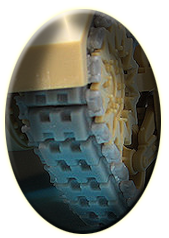sherman Track history


There are two styles of Sherman Tracks: the Vertical Volute Suspension System (VVSS) and the Horizontal Volute Suspension System (HVSS). All of the Panda line tracks are for VVSS Shermans. All VVSS tracks with the exception of some Canadian manufactured Shermans used track blocks that were 16 or 16.5 inches in length and held together by end connectors that also served as track guides. A special wedge shaped bolt secured the end connectors and also put stress on each shoe that caused it to curl (commonly referred to as a “live track”) and made it easier for the track to stay on the rear idler wheel when the tank was moving.
During the War, many different track styles were developed including rubber, rubber backed steel and all steel tracks. As a rule of thumb, rubber block tracks were the most common tracks found on Shermans until mid 1942. With the approach of the war the Army sought to reduce the use of strategic materials such as rubber. Because tracks accounted for approximately 10-15% of the Army's total rubber allotment, the Army ordered development of an all-steel track block. These steel blocks had relatively shallow integral grousers because deep grousers were too hard on the suspensions and increased rolling resistance. Although these designs had long life and durability in rocky and sandy soil conditions, their traction on paved surfaces was poor and as mentioned previously, they wore out suspensions easily. It should be noted that improved rubber track designs were developed to capitalize on the benefits of rubber. Rubber tracks were quieter, could be made to develop good traction off road, and did less damage to paved roads. Rubber track production continued throughout the War. As a compromise rubber-backed steel tracks of various grouser designs were eventually developed combining the conservation and wear properties of steel tracks with the suspension-saving features of rubber. The most commonly used types of Sherman tracks, both rubber and steel, have been replicated by Panda and a brief summary of each can be found on each of the following web pages. All sets are available at $21.95 plus postage. We do not charge for packaging or handling.
The question inevitably comes up as to which track to use for a specific tank or specific unit. The answer seems to be that the track type used by a particular unit or vehicle was far from uniform. Units were more likely than not to have as many several different track styles in use depending on what came with the replacement vehicles. Some units have been known to be using as many as four different track styles in use. While it appears that the majority of M7 and M10 motor carriages used rubber tracks, instances can be found of even these vehicles fitted with alternative tracks styles.
Back to top